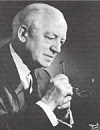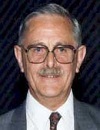History of the centre
History of occupational medicine and occupational hygiene in Manchester
It is fitting that the University of Manchester, with its civic tradition and location in the industrial heartland of Britain, should host an academic unit of occupational health.
Ronald Lane, the first Professor of Occupational Medicine at the University of Manchester, was appointed in 1945 and his tenure was the longest of the Professors to date, lasting until 1964. During this time research was undertaken in many diverse areas, ranging from lead poisoning to byssinosis (the dust-related disease in cotton workers). Richard Schilling (biochemist and occupational physician) joined as a Reader and deputy to Ronald Lane in 1947, where he began a study of byssinosis. Upon Ronald Lane's retirement, he was succeeded by TS Scott.
The history of occupational medicine and hygiene in Manchester and elsewhere owes a great deal to several people who are sadly no longer with us. We keep their memory alive through our work.
Professor Ronald Lane

2 July 1897 - 14 March 1995
His interest in occupational medicine developed early with his appointment at the age of 30 as medical officer to the Chloride Electrical Storage Company. Like many of the other occupational medicine 'greats' of earlier years, his initial work was in lead. His researches were diligent, painstaking and thorough, and the quality of his work was recognised when he became a member of the Industrial Health Research Board in 1937.
The son of a village schoolmaster, he had been in the RFC and RAF between 1915 and 1919. He had a distinguished student career, including house appointments at his teaching hospital, and quickly gained his MRCP whilst working in general practice in Nottingham. During the 1930s, Lane held appointments at the Salford Royal Infirmary, becoming Physician in 1937 and elected FRCP in 1939.
During World War II, Lane became very active in research and research management for the Occupational Health Committee of the MRC. He began part-time training courses for the doctors and nurses that industry called upon to care for war workers during those years. He thus became the obvious candidate for the first Chair of Occupational Health to be set up in the UK. This was in Manchester and was funded and named after the Nuffield Foundation.
Between 1945 and his retirement in 1964, Ronald Lane established a thriving department and an intellectually challenging academic environment. Important studies into lead, cadmium and cotton dusts were examples of the many strands of research which were pursued at the time and whose outcome we now find in our textbooks.
Ronald believed very strongly in the essential clinical nature of our speciality and saw patients and retained hospital beds throughout his career. He spent an active retirement consulting, teaching, playing golf and bridge and working in his extensive garden.
His demanding intellect was tempered by a lovely sense of humour and an enormous enthusiasm for our specialty.
Ronald Lane: My fifty years in industrial medicine
AJM Slovak
From Occupational Medicine 1995; 45(6): 330
Reproduced by kind permission of the Editor and Publisher of Occupational Medicine
Professor Jerry Sherwood

Professor Sherwood and his book collection
Jerry Sherwood was a leading figure in British occupational hygiene. He graduated from Imperial College London in mechanical engineering in 1944, at the age of 19. He spent the last few months of the war as ground crew in the Fleet Air Arm and Royal Canadian Navy (beginning a familiarity with aircraft that he would much later apply in monitoring environmental noise for his fellow-residents around Abingdon airfield).
An apprenticeship with Vickers followed and, during subsequent work for them on gas turbines, he became interested in the working environment. In 1949 he went to Harvard with a Nuffield Fellowship to take their masters course in Industrial Hygiene. He returned to begin his energetic and many-faceted work in the field. Nuffield funding established the UK's first occupational hygiene service, with field work based at Slough and laboratories at the London School of Hygiene and Tropical Medicine. Jerry was health engineer at Slough and lecturer in the School and was soon involved in surveys of toxic substances, thermal environment and lighting.
Around 1958 Jerry developed the first pump driven personal sampler and within a few years the pumps had become the indispensable tools they are today (Sherwood and Greenhalgh, 1960; Sherwood, 1997). Jerry soon showed that personal exposures could exceed many-fold the concentrations measured in nearby air by conventional methods and personal sampling became the norm.
At Slough, he married his pioneering occupational hygiene service work with research and by the time he moved to the Atomic Energy Research Establishment at Harwell in 1955, he was already author of several journal publications. His work on improved samplers at Harwell went with his management of a hygiene service there and work on respirators which led to the first quantitative fit test (Hounam et al, 1964). Having become a CIH, Jerry moved to Esso Europe in 1964, to advise on organisation of occupational hygiene and environmental protection in affiliated companies. Typically, he found time to develop a miniature sampler for sulphur dioxide, which was widely used throughout Europe and became available in a commercial version.
Leaving AERE, Jerry joined Colt, but a couple of years later left, to begin his influential period in various parts of the developing world. He had had a 'taster' for this work in 1974-5 with ILO, initiating an industrial hygiene laboratory in Teheran, but his first long ILO posting was two years from 1977 in Sri Lanka, assisting the government in establishing an Institute of Occupational Safety. A similar appointment in Korea followed and after that he undertook shorter spells for WHO in Malaysia, Singapore, Iran again, China, the new Baltic States and Warsaw, as well as an appointment with the Bahrain Petroleum Company.
Back in the UK, Jerry became in 1985 Professor of Occupational Health and Safety at Portsmouth Polytechnic, working in the training area in the development of flexible learning material. Other academic appointments followed, at the University of Surrey, University of California and finally a four-year spell back where he started in occupational hygiene, as Senior Lecturer in Industrial Hygiene at Harvard School of Public Health. In 1987, Jerry received the Yant Award from AIHA and in 1994 the Meritorious Achievement Award of ACGIH. He became in this period an Emeritus Member of ACGIH and an Honorary Member of AIHA. Following his retirement from full-time employment in 1994, he plunged into a new round of professional activity. He was heavily involved with the ACGIH Biological Exposure Indices Committee, almost until his death. For this he drew on his past work on uranium - he had been President of the British Institute of Radiation Protection - and, especially, the work he had begun on benzene metabolism while with Esso.
Jerry Sherwood was a founder member of the British Occupational Hygiene Society and was its president in 1966. By 1974, there was growing feeling that the profession needed clearer organisational identity and Jerry was one of those who argued for the formation of a professional institute separate from BOHS, which became a reality in the following year. In due course Jerry became an Honorary Fellow of the Institute, as well as an Honorary Member of BOHS.
In view of the vast reach of Jerry's work (and his influence as an initiator and trainer in many developing countries) it was very appropriate that IOHA should choose to give Jerry a lifetime achievement award at its 2000 conference in Cairns, Australia on Occupational Hygiene in Developing Countries. Typically, even at the age of 75, he had submitted a paper on biological monitoring as well as his award lecture. Tragically, as the delegates gathered at Cairns, Jerry and his wife Naomi were killed in a car accident in Queensland.
Acknowledgements:
We are very grateful to Philip Sherwood, the son of Professor Jerry Sherwood, for kindly donating the books constituting the Sherwood Collection to the Centre for Occupational and Environmental Health at the University of Manchester.
Dr Trevor Ogden, Editor of the Annals of Occupational Hygiene is thanked for providing this biographical account based on Jerry Sherwood's obituary.
Dr Philip Wilson
Dr Philip Wilson graduated in Liverpool in 1954. After house officer posts in Liverpool he returned to his native Ipswich where he practised as a General Practitioner but took a special interest in occupational medicine. This started with his family's large firm of agricultural merchants and led to an appointment as staff medical officer to Ipswich Hospitals. He subsequently developed an occupational health service for Ipswich Health District, then for the whole of Suffolk and finally served on the Department of Healths Standing Medical Advisory Committee on Occupational Health.
When in 1994 his contemporaries held their 40th Anniversary they were sad to hear that Philip could not join them as he was suffering from two apparently unrelated afflictions, a major resection of a malignant mandible and a progressive multiple system atrophy to which he knew he would succumb in two years. At the reunion his friends agreed to fund a prize in Philip's name to stimulate interest in occupational medicine.
